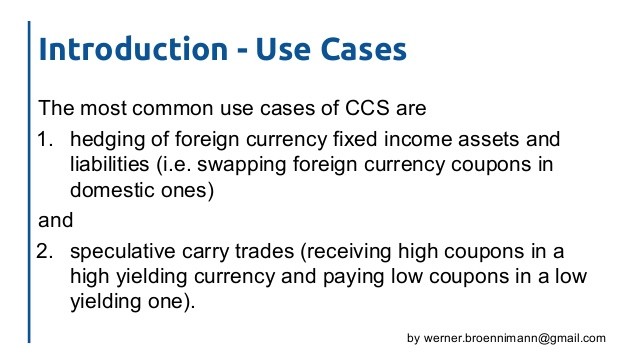Hedging With Currency Swaps_1
Post on: 23 Май, 2015 No Comment

Since swaps have a dual nature (being two-legged structures), swap hedging can be quite an easy and straightforward endeavor. In general, a swap consists of two streams of cash flows, one on each leg. Knowing how to hedge each leg separately is essential to know how to hedge the swap that is, by very nature, equivalent to a long position on one leg and a short position on another. For example, a cross-currency swap can be viewed as an exchange of two fixed-rate bonds, each denominated in a different currency. To value each bond, the yield curves can be consulted, using the spot exchange rate to figure out the difference in value (the present value based on off-market or mark-to-market valuation).
Alternatively, solving for one coupon rate that will set the difference to zero can also help derive that value. Hedging each bond separately will be instrumental to hedging the swap in whole (actually, a swap is equivalent to a long position in one bond and a short position in another). Also, each cash flow exchange can be valued on a currency forward mark-to-market basis, with the total of all cash flows being the swap value. In this respect, hedging a swap is merely a process of synthesizing the opposite of each forward to offset exposure. In the same token, an interest rate swap can be hedged using a series of Eurodollar futures or a duration-equivalent bond. In other words, an interest rate swap can either be hedged with bonds or Eurocurrency positions denominated in each currency combined with spot foreign exchange trades. Alternatively, this can implemented using spot and forward foreign exchange markets.
Swap dealers, however, implement hedging on a net basis for entire books of swaps. The cash flows of component swaps in the book may offset each other financially (for legs with matched dates) or economically (for legs of the same type but with different maturities). In this sense, a dealer can construct an optimal hedge strategy based on the net value sensitivities for the swap book to a range of liquid hedge instruments. The optimal hedge is, by definition, dynamic, flexible and liquid (e.g. it is easy to reshuffle and redeploy when new swaps are placed on the book, easy to undo when unwinds are required, etc). This involves hedging dynamically daily changes in the net value of the book (portfolio of swaps), as the book itself changes due to the addition of new deals or the removal of existing swaps (unwinds).














